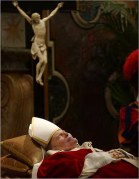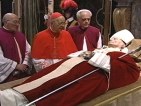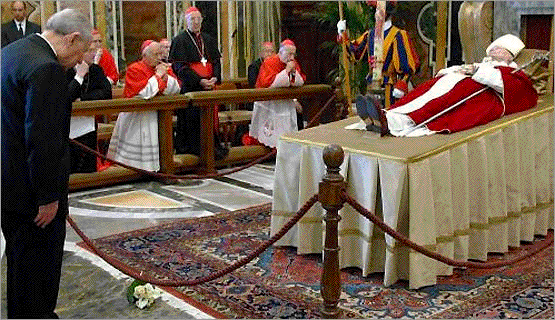

Pope John Paul II | home
In Memory | Obituary | Pope Facts | Timeline | Pope Lies In State | Public Viewing | Funeral | Funeral Service | VIP's @ Funeral | Papal Travels, 1978~2004 | Pope Meets World Leaders | Man of the Year | Special Links
Pope Lies In State

Brilliant Light For The World
ROME — Dignitaries, associates and friends of Pope John Paul II athered at the Vatican on Sunday as tens of thousands paid their respects at the Apostolic Palace, where the pontiff's body was on display a day after he died in his apartment at the age of 84.
The Sunday viewing, a Roman Catholic ritual to certify and confirm death, drew about 100,000 in all — an estimated 80,000 inside the building and 20,000 more lining the streets outside.
On Monday, the people will have their turn to say good-bye to Pope John Paul II, when he will be transferred to the famed St. Peter's Basilica, also in Vatican City, for a service open to the general public.
"Even if we fear we've lost a point of reference, I feel like everybody in this square is united with him in a hug," said Luca Ghizzardi, a 38-year-old nurse with a sleeping bag and a handmade peace flag at his feet.
Estimates are that at least 2 million people from around the world will come to Rome this week to celebrate his life and mourn his death.
"He was such a brilliant light for the world," Cardinal Roger Mahony of Los Angeles said after visiting the room where the pope's body lay in state, comparing John Paul II's life to the candle burning at his bedside.
After midnight in Rome there was no official word on when the funeral and burial would be, though Catholic tradition calls for it to happen between four and six days after death. Nor was it announced Sunday night where the pope — who left explicit instructions on what he wanted in death — would be buried.
President Bush was expected to attend the funeral, though he was said to be awaiting an official invitation from the Vatican before making a formal announcement. The ceremony and service will draw other world leaders as well as Vatican hierarchy and ordinary faithful.
Finally at rest after years of crippling disease, Pope John Paul II's body lay in state Sunday, his hands clutching a rosary, his pastoral staff under his arm. Millions prayed and wept at services across the globe, as the Vatican prepared for the ritual-filled funeral.
Rome wasn't the only place where people were honoring Pope John Paul II's long life and death on Sunday. People around the world and across the United States were streaming in and out of churches and other places of worship to pray for him.
In Rome, thousands of VIPs converged on St. Peter's Square to attend the memorial Mass Sunday honoring the international leader of the Roman Catholic Church.
The Vatican's secretary of state and No. 2 official, Cardinal Angelo Sodano, led the Mass for the repose of the pope's soul from the steps of St. Peter's Basilica.
"We entrust with confidence to the risen Christ, Lord of life and history, our beloved John Paul II who for 27 years guided the universal church as the successor of Peter," he said.
Applause rang out when Sodano prayed for the pope's soul at the start of the Mass, an Italian gesture of respect for the dead. About 80,000 people attended Mass, with around 20,000 more spilling into the surrounding boulevards, police said.
In the United States, Americans across the nation also mourned the pope, with flags flying half-staff at the White House in Washington and at St. Patrick's Cathedral in New York.
"I admired Pope John Paul II," Edward Cardinal Egan, head of the New York Archdiocese, told worshippers at one of the Sunday Masses at St. Patrick's, on Fifth Avenue in Midtown Manhattan.
"I came to pay my respects and offer my condolences on behalf of the Holy Father," said U.S. Secretary of State Condoleezza Rice, calling John Paul II "a man of peace, a man of compassion" among "people of faith."
The pope died Saturday of septic shock and an irreversible cardio-circulatory collapse, according to the official death certificate released on Sunday by the Vatican.
The death certificate listed the ailments he suffered, including Parkinson's disease, which he'd been living with for some time. After being hospitalized twice in the last two months, in his final days he faced heart and kidney malfunction. His last public appearance was the Wednesday prior to his death.
Prelates and Italian Premier Silvio Berlusconi were among those who stood in line to pay their respects at the viewing and Mass in Rome. John Paul II's longtime personal secretary, Archbishop Stanislaw Dziwisz, sat in prayer in a pew and then greeted prelates and dignitaries. At times he was seen wiping tears from his eyes.
After the Mass ended, Archbishop Leonardo Sandri, who had become the pope's public "voice" in his final weeks, read the traditional Sunday noontime prayer, which John Paul II delivered throughout his pontificate. The crowd applauded when Sandri announced that the late pope had actually prepared the prayer himself before he died, saying he was reading it "with such honor, but also such nostalgia."
Early Sunday, a text message had circulated on cell phones in Rome, asking people to light candles in their windows. "May they light up the road to God for him, the way he did for us," the message said.
Around the world, bells tolled and worshippers prayed in remembrance of the man who reigned for longer than all but two previous popes and who was credited with helping bring down communism in Europe and spreading a message of peace during his frequent travels around the world.
John Paul II, who was 58 when the cardinals elected him the first non-Italian pope in 455 years, also left a legacy of conservatism. He opposed divorce, birth control and abortion, the ordination of women and the lifting of the celibacy requirement for priests.
The mourning stretched from the pope's native Poland, where 100,000 people filled a Warsaw square at the spot where he celebrated a landmark Mass 26 years ago that inspired opponents of the communist regime, to the earthquake-devastated Indonesian island of Nias, where a priest led special prayers. In Paris, the great bell of Notre Dame sounded 84 times — once for each year of the pontiff's life — as a crowd of 25,000 massed outside.
"It's a great loss for Poland," said Jozef Romanzuk, 40, a businessman standing in front of St. Anne's Cathedral in Poland. "The pope was a symbol of the new Poland. Now, we are beginning a new history, in which we Poles are left alone."
In New York, the response was similar. "I love this man a lot," said Zygmunt Sawicki, 69, of Brooklyn, N.Y., who came to the United States from Poland 26 years ago. "It’s such a great shock."
In Los Angeles, former first lady Nancy Reagan, wife of President Ronald Reagan, spoke of the friendship and the similarities between the two great world leaders.
The two were united by their joint fight against communism, their assassination attempts about six weeks apart in 1981 and even their deaths just nine months apart, Mrs. Reagan said in a cable TV news interview.
There were surprising similarities, too, she added: Both were former actors, shared the "great communicator" title and loved sports.
"They were very much alike," said Mrs. Reagan, who met the pope seven times. "They crossed paths a lot."
The viewing Mass began with a solemn parade of the College of Cardinals down the steps of the basilica as a choir sang. Each cardinal, dressed in a flowing white robe with a golden cross on the chest, kissed the altar before taking his seat. Sodano wore golden vestments.
Vatican television showed the pope clad in crimson vestments, his head covered with a white bishop's miter.
Television images gave the public its first view of the pope since his death: lying in the Vatican's frescoed Apostolic Palace, dressed in crimson vestments and a white bishop's miter, his head resting on a stack of gold pillows. A Swiss Guard stood on either side as diplomats, politicians and clergy paid their respects at his feet.
Outside, the throngs of pilgrims who filled the square Sunday joined some of the faithful who had held an overnight vigil in the piazza after learning of the pontiff's death.
Many were holding flags, banners, newspaper photographs of the pope and rosaries, and few dry eyes could be seen in the crowd. First aid stations and ambulances lined the avenue, ready with water and medical help in case anyone needed it.
On Saturday, the pope's death was announced in this statement from the Vatican: "The Holy Father died this evening at 9:37 p.m. [2:37 p.m. EST] in his private apartment. All the procedures outlined in the apostolic Constitution 'Universi Dominici Gregis' that was written by John Paul II on Feb. 22, 1996, have been put in motion."
The announcement came from papal spokesman Joaquin Navarro-Valls and was distributed to journalists via e-mail. In keeping with the pope's reputation as a great and progressive communicator, the Vatican has been quite communicative itself, keeping its press office open overnight Friday and releasing regular updates since John Paul II took a serious downturn late last week.
Navarro-Valls said that upon being informed of the masses of young people holding vigil outside his window, the pope, who had worked so tirelessly advocating for the world's young, said: "I have looked for you. Now you have come to me. And I thank you."
According to his aides, John Paul II reportedly looked out the window and uttered his last word: "Amen."
John Paul II expired as cardinals were leading some 70,000 people at St. Peter's Square in prayers for the pope in his "last journey."
Bells tolled at the Vatican and across Rome, and Vatican, Italian and European Union flags were being lowered to half-staff across the capital.
In the United States, President Bush ordered flags lowered at the White House and all federal buildings and military facilities until the pope is buried.
"The world has lost a champion of human freedom," Bush said Saturday before attending Mass with first lady Laura Bush. "A good and faithful servant of God has been called home."
In Baghdad, Iraq, services were also held.
"It may be a blessing for him at this point to rest a little," said Col. Ann Mancino of the 228th Combat Support Hospital. "Obviously it made us sad, but happy that he's now with God in heaven."
Former Presidents Bill Clinton and Jimmy Carter both issued statements reflecting on the pope's life and death.
"Hillary and I are deeply saddened by the passing of His Holiness, Pope John Paul II," President Clinton said. "In speaking powerfully and eloquently for mercy and reconciliation to people divided by old hatreds and persecuted by abuse of power, the Holy Father was a beacon of light not just for Catholics, but for all people."
And in what may be the most profound testament to John Paul II's capacity to reach across borders, the news of his death sent Catholics, Protestants, Jews and Muslims to their respective houses of worship to pray for him.
He was the first pope to visit a mosque, in May 2001 in Damascus, Syria, touring a 1,300-year-old Islamic house of worship and urging Muslims and Christians to stop their centuries-old wars over land and doctrine.
And he was the first to visit a synagogue in Rome, which he did in April 1986, in nearly 2,000 years — since the time of St. Peter.
The gesture was seen as an official recognition of the Second Vatican Council (’s'); call for increased tolerance among Catholics and other religious followers.
In spite of some of those efforts and his well-documented battle against anti-Semitism, the pope never won the Nobel Peace Prize — though he had been a candidate for it for many years.